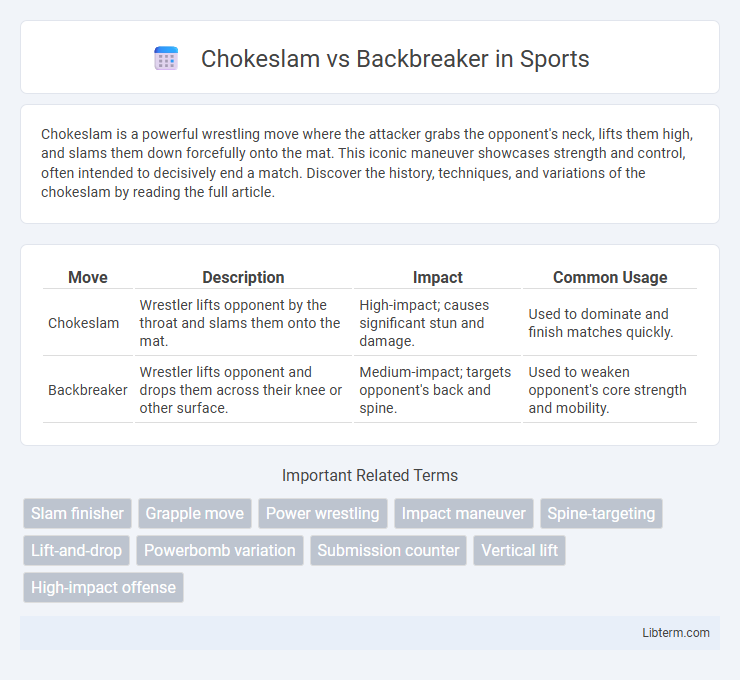Chokeslam is a powerful wrestling move where the attacker grabs the opponent's neck, lifts them high, and slams them down forcefully onto the mat. This iconic maneuver showcases strength and control, often intended to decisively end a match. Discover the history, techniques, and variations of the chokeslam by reading the full article.
Table of Comparison
| Move | Description | Impact | Common Usage |
|---|---|---|---|
| Chokeslam | Wrestler lifts opponent by the throat and slams them onto the mat. | High-impact; causes significant stun and damage. | Used to dominate and finish matches quickly. |
| Backbreaker | Wrestler lifts opponent and drops them across their knee or other surface. | Medium-impact; targets opponent's back and spine. | Used to weaken opponent's core strength and mobility. |
Introduction to Chokeslam and Backbreaker
The Chokeslam is a powerful wrestling move where the attacker grasps the opponent's neck, lifting and slamming them onto the mat, showcasing sheer strength and impact. The Backbreaker targets the opponent's back by lifting and dropping them across the attacker's knee, emphasizing spinal damage and submission potential. Both maneuvers are staples in professional wrestling, each highlighting different aspects of wrestler dominance and tactical versatility.
Origins and History of the Chokeslam
The chokeslam, a wrestling move where the opponent is lifted by the throat and slammed onto the mat, originated in the early 1980s and gained popularity through iconic wrestlers like The Undertaker and Kane. Its history traces back to traditional power moves used in territorial wrestling before becoming a signature finisher in modern professional wrestling. The backbreaker, contrastingly, involves dropping an opponent onto the wrestler's knee, focusing on back damage rather than the sheer impact emphasized in the chokeslam.
Evolution of the Backbreaker Move
The evolution of the backbreaker move traces its roots to early professional wrestling, where it has transformed from a basic spine-focused slam to more dynamic variations such as the Argentine backbreaker rack and the inverted backbreaker drop. Unlike the chokeslam, which emphasizes raw power by lifting and forcefully slamming the opponent, the backbreaker targets the opponent's back with precision, combining impact and leverage to immobilize or weaken. Modern adaptations incorporate aerial techniques and chain maneuvers, solidifying the backbreaker as a versatile and technical move distinct from the brute strength showcase of the chokeslam.
Key Differences Between Chokeslam and Backbreaker
The key differences between a Chokeslam and a Backbreaker lie in execution and impact focus; a Chokeslam involves lifting the opponent by the neck and slamming them onto the mat, emphasizing upper body strength and vertical force. In contrast, a Backbreaker targets the opponent's spine by dropping them back-first across the attacker's knee, concentrating damage along the back and core. These distinct mechanics result in varied offensive strategies and types of injury simulation within professional wrestling.
Signature Wrestlers Known for Chokeslam
The chokeslam is a powerful finishing move famously employed by wrestlers like The Undertaker, Kane, and Big Show, each known for their dominance in the ring and larger-than-life personas. This move involves grabbing the opponent's throat and slamming them onto the mat, showcasing strength and control. In contrast, the backbreaker, popularized by stars like Chris Jericho and Shawn Michaels, targets the opponent's spine for a different style of impactful signature maneuver.
Legendary Performers of the Backbreaker
The backbreaker, a submission move that targets the spine, has been famously executed by legendary wrestlers such as The Undertaker, Kane, and Chris Jericho, each enhancing its impact with unique variations like the Tombstone Piledriver or the Codebreaker. These iconic performers elevated the backbreaker by combining power and precision, establishing it as a signature move that inflicts significant damage and often leads to match-winning scenarios. Their mastery of the backbreaker solidified its place in wrestling history, showcasing the move's versatility and devastating effectiveness in the ring.
Technique Breakdown: Chokeslam Execution
The Chokeslam technique involves firmly grasping the opponent's neck with one hand while lifting them off the ground using explosive power from the legs and core. The wrestler maintains control by ensuring a secure grip on the throat area, enabling a high-impact slam onto the mat. Proper Chokeslam execution demands precise timing and upper body strength to maximize both the elevation and force of the maneuver.
Anatomy of the Backbreaker: Variations and Styles
The backbreaker targets the spine by applying focused pressure to the lower or mid-back, often executed by dropping or slamming the opponent backward onto the attacker's knee or similar surface. Variations include the full nelson backbreaker, where the opponent is lifted and controlled before impact, and the pendulum backbreaker, which combines rotational momentum to enhance spinal compression. Different styles emphasize specific anatomical stress points such as vertebrae alignment, intervertebral discs, and surrounding musculature, aiming to incapacitate through localized trauma or pain.
Impact and Effectiveness in the Ring
The Chokeslam delivers a powerful lifting and slamming motion that causes significant impact by driving the opponent's back and shoulders into the mat, often stunning or incapacitating them immediately. In contrast, the Backbreaker targets the opponent's spine with precise force by bending their back over the wrestler's knee, effectively wearing down their mobility and causing lasting pain during the match. The Chokeslam excels in dramatic, high-impact scenarios to control the pace, while the Backbreaker serves as a strategic move to weaken an opponent's core strength and flexibility over time.
Audience Reception and Legacy of Both Moves
The chokeslam generates intense crowd reactions with its dramatic lift and slam, often used to showcase dominance and power in wrestling matches. The backbreaker elicits strong audience engagement through its visual impact and pain-inducing portrayal, frequently highlighted in storytelling as a painful finishing or weakening move. Both moves hold significant legacies in professional wrestling, with the chokeslam closely associated with iconic super-heavyweight wrestlers, while the backbreaker is renowned for its versatility and technical prowess across multiple wrestling styles.
Chokeslam Infographic

 libterm.com
libterm.com